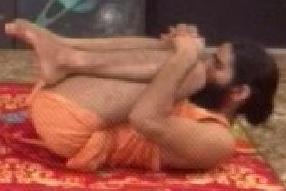Pawanmuktasana | Wind Releasing Pose
Pawanmuktasana is a sanskrit word. Pawan means wind or air, and mukta means releasing. As the name describes, gas is released from stomach digestive tract by practicing this asana. Pawanmuktasana or wind releasing pose is an excellent asana for stomach and digestive organs.
Procedure
1. Lie down flat like shavasana.
2. Bend the right knee up to the stomach as much as possible. Exhale and pull right knee to touch the chest with help of both hands by interlocking fingers, just below the knee. Now raise the head and touch the nose to the knee. If not possible to touch, try to do as nearest as possible. Stay at this pose from 10 to 30 seconds with keeping breath out.
3. Now repeat the same procedure with left leg.
4. At last, the same process is repeated with both the legs simultaneously. This way, one cycle or series is completed. The whole process is repeated 3-5 times.
Duration
Pawanmuktasana or Wind Releasing Pose is a very easy asana. It can be performed 3-5 complete cycles with each leg and both legs.
Benefits
- This asana is exactly like it’s name. Best for releasing air from the intestines.
- Very relaxing and good asana pose for women with uterus problems.
- Pawanmuktasana is very helpful in slip disc, sciatica and waist pain. Good for acidity, gas, heart problems, arthritis and waist pain. It reduces extra abdominal fat.
Precautions
It you have sever pain in the back or waist and not able to touch the nose to knee, don’t do it, but still try to do as nearest as possible. Pawanmuktasana is very helpful in slip disc, sciatica pain and waist pain.

